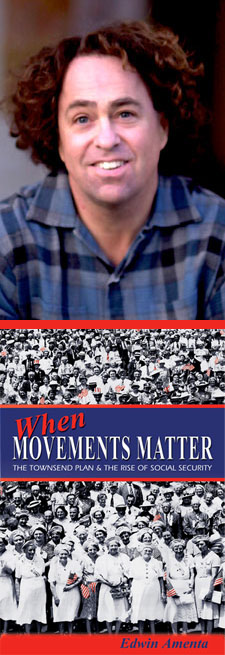What can social security teach us about health care reform?
What can social security teach us about health care reform?
- March 30, 2010
- UCI sociologist Edwin Amenta explains
-----
 President Obama’s final signing today of the newly enacted health care reform law
has been met with equal parts applause and calls for repeal as both the plan and events
leading up to its passing have deeply divided the American public and equally polarized
the country’s two-party political system. This is not the first time, however, that
such sweeping legislation has caused a nationwide raucous, says Edwin Amenta, UCI
sociologist and author of When Movements Matter: The Townsend Plan and the Rise of Social Security. He notes that recent events surrounding health care reform have much in common
with the enactment of the social security program 75 years ago. Here, he offers insight
on what the history of social security can teach us about the potential future of
health care reform.
President Obama’s final signing today of the newly enacted health care reform law
has been met with equal parts applause and calls for repeal as both the plan and events
leading up to its passing have deeply divided the American public and equally polarized
the country’s two-party political system. This is not the first time, however, that
such sweeping legislation has caused a nationwide raucous, says Edwin Amenta, UCI
sociologist and author of When Movements Matter: The Townsend Plan and the Rise of Social Security. He notes that recent events surrounding health care reform have much in common
with the enactment of the social security program 75 years ago. Here, he offers insight
on what the history of social security can teach us about the potential future of
health care reform.
Q: How are the enactments of recent health care reform and the 75-year-old social security system similar?
Both policies were initially passed after a major partisan shift in the electorate
to the left. In 1934, the Democrats won tremendous victories during the midterm
congressional elections, taking much of the North and providing President Franklin
Roosevelt a political coalition for reform. Similarly, President Barack Obama was
swept into office with a reform-oriented Democratic Congress last year. Both presidents
skillfully deployed these majorities to pass sweeping new social benefits.
Q: Was the establishment of social security met with as lively a debate as we’re seeing
today with health care reform?
The social security legislation was not enacted without a major struggle. Republicans
and business interests tried their best to stop the initial social security legislation
and worked with conservative Southern Democrats, whose electorate was largely disfranchised,
to prevent the reform from becoming more generous and extensive. Republicans continued
to attack the social security legislation after its passage. The 1936 Republican
presidential nominee Alf Landon made a major campaign issue over the government intrusion
represented by Social Security cards and numbers. But Landon was crushed, and the
principle of social security was established. After the election, the Republican
Senator Arthur Vandenberg of Michigan gained more political traction arguing that
the social security payroll tax prevented business recovery.
Q: What lessons can today’s policy makers, politicians and the general public take
away from past experiences implementing a controversial nationwide program?
When first enacted, social security was a work in progress. It initially covered
only about half the labor force; its benefits were scheduled not until after seven
years; and a competing program for poorer Americans competed with it for attention.
Congress transformed the social security program in 1939, after a Republican resurgence
in Congress, altering its benefit structure and lowering its payroll tax. It was
not until 1950 that social security assumed the form that it has today. Today’s Republicans
similarly are seeking to repeal the health care legislation. But history suggests
it will be more feasible to limit its scope or lower its benefits. The history of
social security also suggests that it may take more than a decade of political struggles
before we know what sort of health policy will ultimately be in place. After all,
many of the provisions of the health care legislation, such as the individual mandate,
will not take effect for some years, and coverage remains far from complete. Yet
the battles will be over the policy’s particulars, not its existence.
Learn more about Amenta's research on social security online.
--photo by Luisa Amenta
-----
Would you like to get more involved with the social sciences? Email us at communications@socsci.uci.edu to connect.
Share on:
Related News Items
- Careet RightNotes from a future professor
- Careet RightCan Opportunity Zones ever meet their poverty-fighting promise?
- Careet RightFei Yuan named one of ten global China Times Young Scholar Fellows
- Careet Right'Wired for Words: The Neural Architecture of Language,' an excerpt
- Careet RightEveryone's looking for a partner who has these 3 traits, according to research


